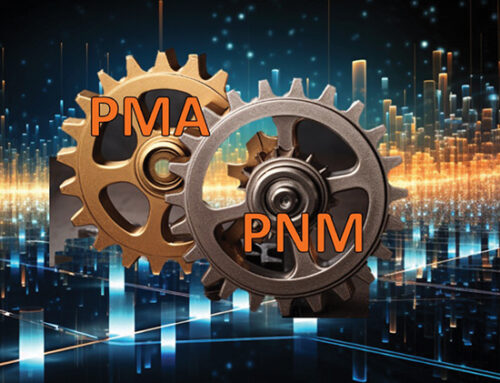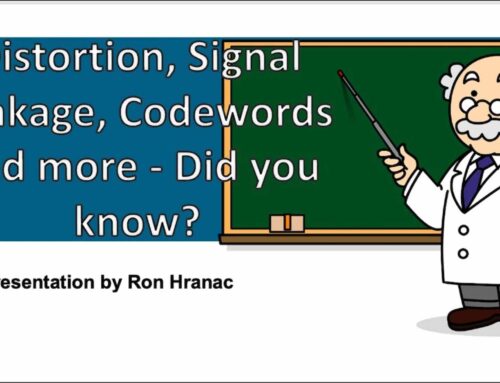DOCSIS Pre-Equalization
This paper will first provide a brief primer on DOCSIS to establish a baseline for the document. Next the paper will examine what is DOCSIS pre-equalization. How DOCSIS pre-equalization works and how DOCSIS pre-equalization can be extended. In the greater context of the paper, the reader must consider the implications of the extensions of DOCSIS pre-equalization. In section 5, details will be provided on how DOCSIS pre-equalization can be used to identify plant impairments and locate those impairments to within a few feet. This turns every cable modem in your network into a very powerful troubleshooting device. The implications are that DOCSIS pre- equalization as a troubleshooting tool will change the cable industries maintenance practices, significantly reduce maintenance costs and dramatically improve subscriber satisfaction with overall service performance, for data and video.
Section 1 – Overview
Contents
This paper will first provide a brief primer on DOCSIS to establish a baseline for the document. Next the paper will examine what is DOCSIS pre-equalization. How DOCSIS pre-equalization works and how DOCSIS pre-equalization can be extended. In the greater context of the paper, the reader must consider the implications of the extensions of DOCSIS pre-equalization. In section 5, details will be provided on how DOCSIS pre-equalization can be used to identify plant impairments and locate those impairments to within a few feet. This turns every cable modem in your network into a very powerful troubleshooting device. The implications are that DOCSIS pre- equalization as a troubleshooting tool will change the cable industries maintenance practices, significantly reduce maintenance costs and dramatically improve subscriber satisfaction with overall service performance, for data and video.
Section 2 – DOCSIS Primer
Data Over Cable Service Interface Specification (DOCSIS) is effectively a transparent Ethernet bridge over a hybrid fiber/coax (HFC) network. There are two (2) functional components in a DOCSIS network, the cable modem (CM) on the subscriber side and the CMTS in the headend or hub site. The CMTS communicates with the CMs on one or more 6 MHz wide (8 MHz in Euro-DOCSIS deployments), 64- or 256-QAM (quadrature amplitude modulation) digitally encoded RF signals on the downstream path of an HFC network between 108 and 1 GHz. The CMs communicate with the CMTS using one or more quadrature phase shift keying (QPSK), 8-, 16-, 32-, or 64-QAM digitally encoded RF signals, transmitted on an upstream HFC frequency between 5 to 85MHz. The digital data, transported via digitally modulated carriers, contains Media Access Control (MAC) information, which enables the CMs to coexist with other CMs by using a Time Division Multiple Access (TDMA) scheme or synchronous code division multiple access (S-CDMA). In essence, the CMTS is the system scheduler, which coordinates the power level, frequency, transmit time, and pre-equalization of all CM signals on the DOCSIS network.
By virtue of the fact that CMs and the CMTS are able to communicate digital data with each other over the HFC network for the purpose of “command-and-control” processes, they are also able to transmit packets containing other non-DOCSIS MAC related data. This is what fundamentally facilitates the ability to send Ethernet traffic bi-directionally over an HFC network. The CMTS-CM DOCSIS network transports IP based traffic in the same method that is used to communicate MAC protocol between the devices. Now that the IP traffic can traverse the HFC network, end users are also able to utilize this network for the purpose of transmitting content destined for the multitude of available data network services such as email, web browsing, IP video, and voice over IP telephony (VoIP).
In summary, each user is assigned a unique cable modem, which conforms to the DOCSIS standard. The CMTS works as a system scheduler enabling many cable modems to reside on the same RF network. TDMA and/or S-CDMA is employed in cable modem communications so that each modem is allocated a certain finite time over which it may transmit and receive IP data. IP data destined for a particular user is sent to that user’s modem by the CMTS one or more downstream RF channel. This is the way an Ethernet network is able to be transparently bridged from a data backbone to a subscriber’s home or business location.
Section 3 – What is DOCSIS Pre-Equalization
DOCSIS pre-equalization is a feature that was first added in the DOCSIS 1.1 standard. The objective of pre-equalization is to improve upstream performance in the presence of certain RF impairments. These impairments include, but are not limited to, frequency response, micro-reflections, and group delay.
The method in which DOCSIS pre-equalization improves upstream performance in the presence of these RF impairments is simple. The CMTS looks at messages coming from the cable modem and evaluates the signal quality of the messages. If the CMTS determines that the messages can be improved by pre-equalization, the CMTS sends equalizer adjustment values to the cable modem. The cable modem applies these equalizer adjustment values, called coefficients, to its pre-equalizer. The result is that the cable modem transmits a pre- distorted signal to compensate for impairments between the cable modem and the CMTS. As the pre-distorted signal traverses the HFC network it will experience the effects of RF impairments. By the time the pre-distorted signal from the cable modem arrives at the CMTS it will no longer have any of the original pre-distortion, as the RF impairments will have transformed it back into a near-ideal signal that the CMTS intended to see. If further adjustments are required, the CMTS will send more pre-equalizer coefficient values to the cable modem and the cycle repeats. This cycle repeats at least once every thirty seconds for every cable modem in the DOCSIS network, provided pre-equalization is enabled in the CMTS.
An illustration of a cable modem signal is perhaps the best way to demonstrate pre- equalization in action. Figure 1 below shows an upstream cable modem signal as seen at the CMTS. This RF signal shows significant roll-off due to plant impairments. This would cause the CMTS to have difficulty-demodulating signal, resulting in codeword errors, lost subscriber data and poor subscriber quality of experience (QoE).
For the rest of the article – PDF – volpe_brady_paper_final
To find out more about PNM you can also attend one of two PNM presentations or watch a brief tutorial overview.
“By using PNM as network probes, cable operators can collect device and network parameters. Combining the analysis of the data along with network topology and device location, it is possible to isolate the source of a problem. A proactive maintenance plan can be developed using this information. PNM is Powered By CableLabs and Enhanced By Nimble This“





Leave a Reply